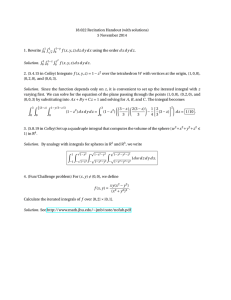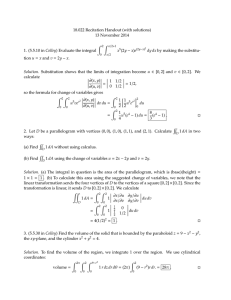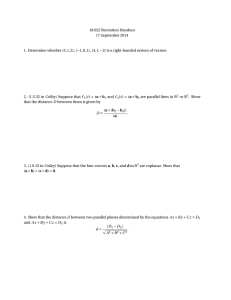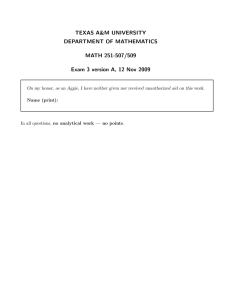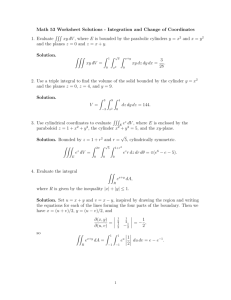18.022 Recitation Handout (with solutions) 01 December 2014
advertisement
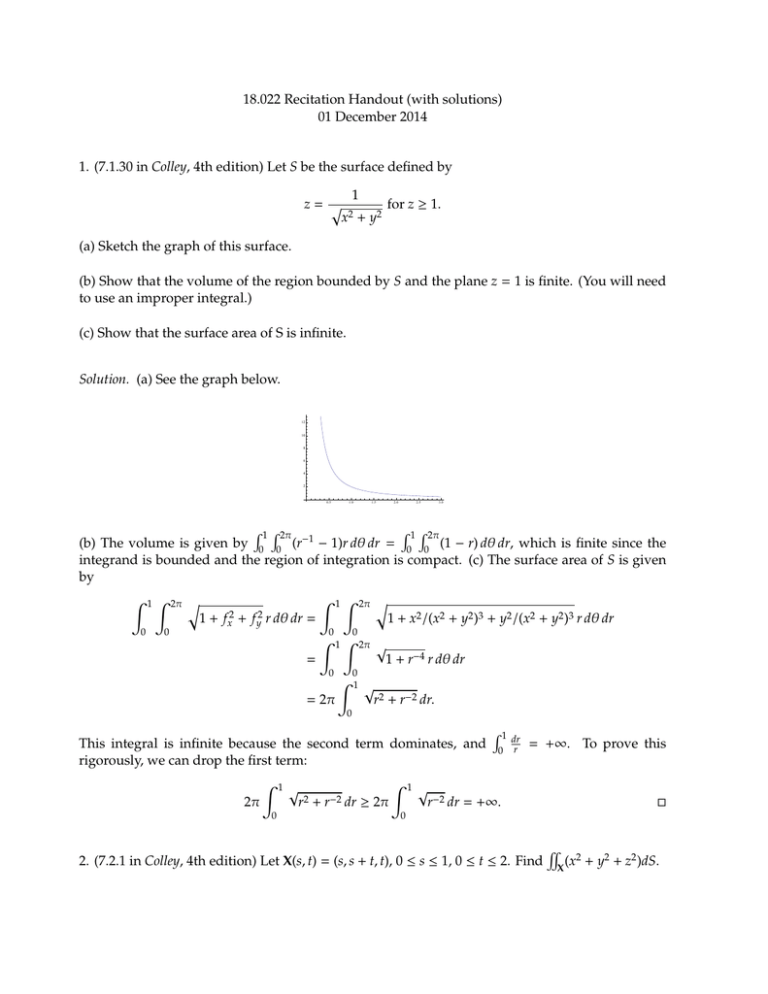
18.022 Recitation Handout (with solutions)
01 December 2014
1. (7.1.30 in Colley, 4th edition) Let S be the surface defined by
z= p
1
x2 + y2
for z ≥ 1.
(a) Sketch the graph of this surface.
(b) Show that the volume of the region bounded by S and the plane z = 1 is finite. (You will need
to use an improper integral.)
(c) Show that the surface area of S is infinite.
Solution. (a) See the graph below.
12
10
8
6
4
2
1.0
0.5
2.0
1.5
3.0
2.5
R 1 R 2π
R 1 R 2π
(b) The volume is given by 0 0 (r−1 − 1)r dθ dr = 0 0 (1 − r) dθ dr, which is finite since the
integrand is bounded and the region of integration is compact. (c) The surface area of S is given
by
Z
0
1 Z 2π
0
Z
q
2
2
1 + fx + f y r dθ dr =
1 Z 2π
0
Z
=
0
1 Z 2π
0
0
1
Z
= 2π
q
1 + x2 /(x2 + y2 )3 + y2 /(x2 + y2 )3 r dθ dr
√
1 + r−4 r dθ dr
√
r2 + r−2 dr.
0
This integral is infinite because the second term dominates, and
rigorously, we can drop the first term:
Z
1
√
2π
0
1
Z
r2
+
r−2 dr
≥ 2π
R1
0
dr
r
= +∞. To prove this
√
r−2 dr = +∞.
0
2. (7.2.1 in Colley, 4th edition) Let X(s, t) = (s, s + t, t), 0 ≤ s ≤ 1, 0 ≤ t ≤ 2. Find
!
X
(x2 + y2 + z2 )dS.
Solution. We have
√
3
1Z
Z
0
2
z
s
}|
∂(x, y)
∂(s, t)
(s2 + (s + t)2 + t2 )
0
!2
+
∂(x, z)
∂(s, t)
!2
+
∂(y, z)
∂(s, t)
{
!2
√
dt ds = 26 3/3 .
3. (7.2.27 in Colley, 4th edition) Let S be the funnel-shaped surface defined by x2 + y2 = z2 for
1 ≤ z ≤ 9 and x2 + y2 = 1 for 0 ≤ z ≤ 1.
(a) Sketch S.
(b) Determine outward-pointing unit normal vectors to S.
(c) Evaluate
!
S
F · dS, where F = −yi + xj + zk and S is oriented by outward normals.
Solution. (a) See the graph below.
(b) The outward pointing unit vectors on the cylindrical part of the cylinder are xi + yj. On the
y
lateral face, the unit normal is √x , √ , − √1 . (c) We calculate over the cylindrical surface S1
z 2 z 2
"
2
"
F · dS =
S1
"
(−y, x, z) · (x, y, 0) dS =
S1
0 dS = 0.
S1
Over the conical surface, we calculate
!
"
"
y
x
1
F · dS =
(−y, x, z) · √ , √ , − √ dS
S2
S1
z 2 z 2
2
"
1
=−√
z dS.
S1
2
To evaluate this surface integral, we use slices
√ perpendicular√to the z-axis. The slice at height z is
a thin circular strip of radius z and width z 2 (the factor of 2 arising from the 45◦ lean). Thus
1
−√
2
"
Z 9
√
1
z dS = − √
2πz(z 2) dz
S1
2 1
h
i9
= 2π z3 /3
1
= −1456π/3.
Adding the contributions from S1 and S2 , we get −1456π/3 .
